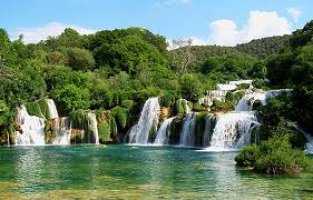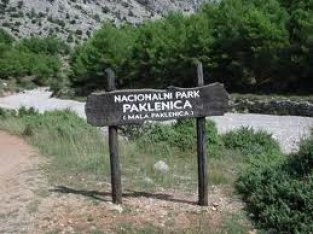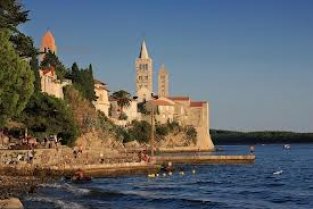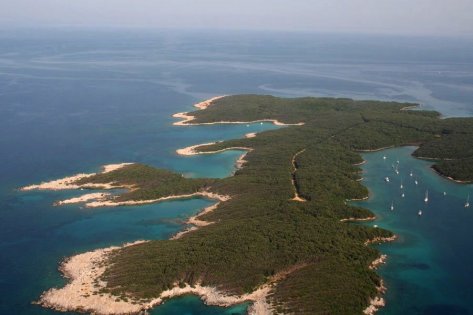Excursions
National Park KRKA
 Krka National Park lies about 10km inland from Sibenik in this part of Dalmatia. Named after the Krka River, the Park covers an area of just over 142 square km and includes two thirds of the river itself. The top attraction of the Park are its magnificent waterfalls, including the famous Skradinski Buk falls which are one of Croatia's most famous sights.
Krka National Park lies about 10km inland from Sibenik in this part of Dalmatia. Named after the Krka River, the Park covers an area of just over 142 square km and includes two thirds of the river itself. The top attraction of the Park are its magnificent waterfalls, including the famous Skradinski Buk falls which are one of Croatia's most famous sights.
Skradinski Buk in Krka National Park
Features of Krka National Park
There's a wide variety of both flora and fauna in the Park. Over 800 species of plantlife have been identified as being present in the National Park. Much of the animal life lives, unsurprisingly, in and around the waters of the Krka River which is home to different amphibian and reptile creatures and there are many different bird species (there are over 200), and 18 different species of bat who call the Park their home.
Roski Slap (slap being Croatian for waterfall) is another famous sight within Krka National Park. A series of 12 waterfalls in a space of 450 metres, the largest is just over 22 metres in height and 60 metres in width. As mentioned, the Skradinski Buk waterfalls are a collection of 17 waterfalls that range in height by over 45 metres.
National Park Plitvice
 The Plitvice Lakes National Park, Croatia's most popular tourist attraction, was granted UNESCO status in 1979. Located roughly halfway between capital city Zagreb and Zadar on the coast, the lakes are a definitely must-see.
The Plitvice Lakes National Park, Croatia's most popular tourist attraction, was granted UNESCO status in 1979. Located roughly halfway between capital city Zagreb and Zadar on the coast, the lakes are a definitely must-see.
The beauty of the National Park lies in its sixteen lakes, inter-connected by a series of waterfalls, and set in deep woodland populated by deer, bears, wolves, boars and rare bird species. The National Park covers a total area of 300 square kilometres, whilst the lakes join together over a distance of eight kilometres.
Picture © Piers Letcher
There's also quite an altitude difference - the highest point is at 1,280m, the lowest at 380m - although the total height difference between the lakes themselves is only 135m. (Veliki Slap, the largest waterfall, is 70m tall.)
National Park Paklenica
 The area had been declared a National Park since 1949, because of the diverse natural environmental and other variety of life in park.
The area had been declared a National Park since 1949, because of the diverse natural environmental and other variety of life in park.
The two most impressive canyons in the National Park Paklenica are Velika (big) Paklenica and Mala (small) Paklenica, which have many rock and cliff formations, a number of caves, and a variety of flora and fauna. There is a monumental vertical gorge, known as Anića Kuk, is one of the most popular terrains for alpinists. The National Park Paklenica is the most significant alpine climbing centre on the Adriatic coast. Today there are about 400 different trails, giving each climber an option to choose his/her own personal trail. There is about 150km of hiking trails in the park, of which the most popular is from the Velika (big) Paklenica canyon to the mountain hut Paklenica, (about a two hour hike).
Entrance into the park is in the town of Starigrad - Paklenica towards Velika (big) Paklenica gorge from the town of Seline towards the gorge of Mala (small) Paklenica. The distance between the gorges is approx. 3km.
Ticket price is 30 kn.
For more information please visit http://www.paklenica.hr/
Zadar
 Zadar is a city with an extraordinary history and extremely valuable cultural heritage. It is located in the very heart of the Adriatic and is one of the most popular tourist destinations in the country. Zadar is said to be a real treasury of archaeological and monumental treasure of all periods. It is most known for the following historical monuments: St. Donat church, Cathedral of St. Stoąije, St. ©ime church, St. Mary’s church and monastery, St. Frane church and monastery, city walls, fortresses and gates and many others. Apart from these historical landmarks, the city is well known for the following attractions: sea organ, solar circle, national square, Five Wells Square, the city’s silver and gold, Forum, Ancient Glass Museum and Kalelarga.
Zadar is a city with an extraordinary history and extremely valuable cultural heritage. It is located in the very heart of the Adriatic and is one of the most popular tourist destinations in the country. Zadar is said to be a real treasury of archaeological and monumental treasure of all periods. It is most known for the following historical monuments: St. Donat church, Cathedral of St. Stoąije, St. ©ime church, St. Mary’s church and monastery, St. Frane church and monastery, city walls, fortresses and gates and many others. Apart from these historical landmarks, the city is well known for the following attractions: sea organ, solar circle, national square, Five Wells Square, the city’s silver and gold, Forum, Ancient Glass Museum and Kalelarga.
Nin
 Nin is a small town in Zadar County with only 1500 inhabitants. The center of this ancient town is a small island (diameter of 500km) which is connected to the mainland with two bridges. It is famous for its turbulent history which is evident from its historical landmarks: St. Kriľ church (“smallest cathedral in the world”), St. Jacob’s church, St. Anselmo Cathedral, remains of the largest Roman temple on the Eastern coast of the Adriatic, Duke Branimir’s statue, Lower town gates and access bridge, royal square with well, statue of bishop Gregory of Nin and the coronation church of St. Nicholas. Other than its historical monuments, Nin is also known for its natural beauty such as the Nin bay, mouth of the Ričina River, “Solana Nin” Nature Park, Nin port and seaside promenade.
Nin is a small town in Zadar County with only 1500 inhabitants. The center of this ancient town is a small island (diameter of 500km) which is connected to the mainland with two bridges. It is famous for its turbulent history which is evident from its historical landmarks: St. Kriľ church (“smallest cathedral in the world”), St. Jacob’s church, St. Anselmo Cathedral, remains of the largest Roman temple on the Eastern coast of the Adriatic, Duke Branimir’s statue, Lower town gates and access bridge, royal square with well, statue of bishop Gregory of Nin and the coronation church of St. Nicholas. Other than its historical monuments, Nin is also known for its natural beauty such as the Nin bay, mouth of the Ričina River, “Solana Nin” Nature Park, Nin port and seaside promenade.
Island of Rab
 Rab island covers 93.6 square km. It is one of the greenest islands in the Adriatic and probably one of the most magical. It is covered with pine forests and has beautiful sandy beaches, and is well known for its mild climate which differs from the mainland. The reason for this is that three ridges are present which protect the island from cold winds from the Velebit mountains.
Rab island covers 93.6 square km. It is one of the greenest islands in the Adriatic and probably one of the most magical. It is covered with pine forests and has beautiful sandy beaches, and is well known for its mild climate which differs from the mainland. The reason for this is that three ridges are present which protect the island from cold winds from the Velebit mountains.
The main resort, Rab Town, is full of medieval buildings, built during the Venetian rule, which occurred since the 13th century. The old town walls are still visible in some places.
Other than the small town of Rab, there are 7 idyllic places on the island situated on different parts of the island: Barbat, Banjol, Palit, Kampor, Mundanije, Supetarska Draga and Lopar.
Island of Olib and island of Silba
Island of Olib is an island in Zadar`s region. It is located eastern of island Silba. Village Olib is the only place on island Olib. Island Olib is connected with the mainland (Zadar) by ferry and it is 2 hours long trip.

Island Olib was first time mentioned in 10th century.
Attractions on island Olib that you should visit:
- Parish Church of Mary`s Assumption
- Tower Kastel from 17th century
- Ruins of St. Paul`s Church and monastery
Inhabitants on island Olib are directed to vine and olive growing and production of cheese. There is no fresh water on island Olib. All homes are built with cisterns for rainwater.
Silba is an island in Zadar's archipelago. It is located south-east of island Losinj and west of island Olib. It is also called the gate of Dalmatia, because it is the most north island of Dalmatian region. Island Silba is 8 km long. Highest peak is hill Varh (83 m). Island Silba has around 270 inhabitants.
Island Silba is special, because there are no cars on island. Only allowed transportation are bicycles and carts. You can get to island Silba by ferries from Pula, Mali Losinj and Zadar. Climate on island Silba is Mediterranean. Average year temperature is 15ºC.
Ports on island Silba are Zalic, located on south-east side of the island, Sv. Ante on south side, Mul on north-east side.
Island Silba has been inhabitated since Roman times. Croats inhabitated island Silba in 8th century. In 1838. Silba was sold to Marko Ragusin from Veli Losinj. After 13 years of lawsuit, island Silba was finally sold to inhabitants. Silba is known for cheese, grapes and wool.
Attractions on island Silba:
- Tower Toreta built in 19th century;
- Parish Church of St. Mary;
- Church of St. Marko;
- Hill Varh...



 Krka National Park lies about 10km inland from Sibenik in this part of Dalmatia. Named after the Krka River, the Park covers an area of just over 142 square km and includes two thirds of the river itself. The top attraction of the Park are its magnificent waterfalls, including the famous Skradinski Buk falls which are one of Croatia's most famous sights.
Krka National Park lies about 10km inland from Sibenik in this part of Dalmatia. Named after the Krka River, the Park covers an area of just over 142 square km and includes two thirds of the river itself. The top attraction of the Park are its magnificent waterfalls, including the famous Skradinski Buk falls which are one of Croatia's most famous sights. The Plitvice Lakes National Park, Croatia's most popular tourist attraction, was granted UNESCO status in 1979. Located roughly halfway between capital city Zagreb and Zadar on the coast, the lakes are a definitely must-see.
The Plitvice Lakes National Park, Croatia's most popular tourist attraction, was granted UNESCO status in 1979. Located roughly halfway between capital city Zagreb and Zadar on the coast, the lakes are a definitely must-see. The area had been declared a National Park since 1949, because of the diverse natural environmental and other variety of life in park.
The area had been declared a National Park since 1949, because of the diverse natural environmental and other variety of life in park. Zadar is a city with an extraordinary history and extremely valuable cultural heritage. It is located in the very heart of the Adriatic and is one of the most popular tourist destinations in the country. Zadar is said to be a real treasury of archaeological and monumental treasure of all periods. It is most known for the following historical monuments: St. Donat church, Cathedral of St. Stoąije, St. ©ime church, St. Mary’s church and monastery, St. Frane church and monastery, city walls, fortresses and gates and many others. Apart from these historical landmarks, the city is well known for the following attractions: sea organ, solar circle, national square, Five Wells Square, the city’s silver and gold, Forum, Ancient Glass Museum and Kalelarga.
Zadar is a city with an extraordinary history and extremely valuable cultural heritage. It is located in the very heart of the Adriatic and is one of the most popular tourist destinations in the country. Zadar is said to be a real treasury of archaeological and monumental treasure of all periods. It is most known for the following historical monuments: St. Donat church, Cathedral of St. Stoąije, St. ©ime church, St. Mary’s church and monastery, St. Frane church and monastery, city walls, fortresses and gates and many others. Apart from these historical landmarks, the city is well known for the following attractions: sea organ, solar circle, national square, Five Wells Square, the city’s silver and gold, Forum, Ancient Glass Museum and Kalelarga. Nin is a small town in Zadar County with only 1500 inhabitants. The center of this ancient town is a small island (diameter of 500km) which is connected to the mainland with two bridges. It is famous for its turbulent history which is evident from its historical landmarks: St. Kriľ church (“smallest cathedral in the world”), St. Jacob’s church, St. Anselmo Cathedral, remains of the largest Roman temple on the Eastern coast of the Adriatic, Duke Branimir’s statue, Lower town gates and access bridge, royal square with well, statue of bishop Gregory of Nin and the coronation church of St. Nicholas. Other than its historical monuments, Nin is also known for its natural beauty such as the Nin bay, mouth of the Ričina River, “Solana Nin” Nature Park, Nin port and seaside promenade.
Nin is a small town in Zadar County with only 1500 inhabitants. The center of this ancient town is a small island (diameter of 500km) which is connected to the mainland with two bridges. It is famous for its turbulent history which is evident from its historical landmarks: St. Kriľ church (“smallest cathedral in the world”), St. Jacob’s church, St. Anselmo Cathedral, remains of the largest Roman temple on the Eastern coast of the Adriatic, Duke Branimir’s statue, Lower town gates and access bridge, royal square with well, statue of bishop Gregory of Nin and the coronation church of St. Nicholas. Other than its historical monuments, Nin is also known for its natural beauty such as the Nin bay, mouth of the Ričina River, “Solana Nin” Nature Park, Nin port and seaside promenade. Rab island covers 93.6 square km. It is one of the greenest islands in the Adriatic and probably one of the most magical. It is covered with pine forests and has beautiful sandy beaches, and is well known for its mild climate which differs from the mainland. The reason for this is that three ridges are present which protect the island from cold winds from the Velebit mountains.
Rab island covers 93.6 square km. It is one of the greenest islands in the Adriatic and probably one of the most magical. It is covered with pine forests and has beautiful sandy beaches, and is well known for its mild climate which differs from the mainland. The reason for this is that three ridges are present which protect the island from cold winds from the Velebit mountains.